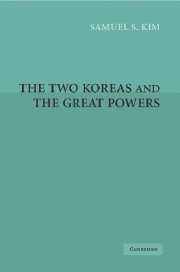Book contents
- Frontmatter
- Contents
- List of Tables and Figures
- Preface
- Chapter 1 Introduction: Korea and the Great Powers in a Changing World
- Chapter 2 China and the Two Koreas
- Chapter 3 Russia and the Two Koreas
- Chapter 4 Japan and the Two Koreas
- Chapter 5 The United States and the Two Koreas
- Chapter 6 The Future of the Two Koreas
- References
- Index
Chapter 2 - China and the Two Koreas
Published online by Cambridge University Press: 25 June 2009
- Frontmatter
- Contents
- List of Tables and Figures
- Preface
- Chapter 1 Introduction: Korea and the Great Powers in a Changing World
- Chapter 2 China and the Two Koreas
- Chapter 3 Russia and the Two Koreas
- Chapter 4 Japan and the Two Koreas
- Chapter 5 The United States and the Two Koreas
- Chapter 6 The Future of the Two Koreas
- References
- Index
Summary
Past experience, if not forgotten, is a guide for the future.
(Qianshi bu wang, houshi zhi shi)
An old Chinese sayingThe China Factor
There is no mistaking the importance of the PRC in post–Cold War Korean foreign relations. The combined weight of history, culture, geography, demographics, military power, political status, and, most recently, market power virtually guarantees that China will be acknowledged as a major player. Consider China's potential trump cards in Korean affairs: (1) demographic weight as the world's most populous country (nineteen times the population of the two Koreas); (2) continental size, as the world's second largest country, forty-four times the size of the Korean peninsula, and territorial contiguity in the sharing of a 1,360-km-long border with almost the entire northern stretch of the Korean peninsula; (3) modernizing military manpower with the world's largest armed forces (but reduced to 2.25 million by 2004) and the world's third largest nuclear weapons stockpile; (4) veto power in the UN Security Council; 5) new economic status as the world's second largest economy (with its gross national income at $5.6 trillion in 2002 and $6.4 trillion in 2003, measured in PPP), the world's fastest growing economy (with per capita GDP passing the $1,000 level in 2003), the world's third largest trading power – with trade reaching $1.15 trillion in 2004, up 36 percent from 2003 – after the United States and Germany but ahead of Japan, the world's largest recipient/destination of FDI (at $60.6 billion in 2004), and the world's second largest holder of foreign exchange reserves at $609.9 billion at the end of 2004; and (6) traditional Confucian cultural influence with strong historical roots.
- Type
- Chapter
- Information
- The Two Koreas and the Great Powers , pp. 42 - 101Publisher: Cambridge University PressPrint publication year: 2006

